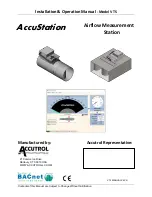
Installation Guide
ECL Comfort 210 / 310, application A214 / A314
2.0 Installation
2.1 Before you start
The Application Key
A214
contains several applications, mainly
related to ventilation systems with heating or cooling or a
combination of these. The applications in the A214 key offer a wide
range of possibilities (see the examples).
The application
A214.1
is very flexible. These are the basic
principles:
Cooling with room temperature control:
Typically, the air duct temperature is adjusted according to your
requirements. The air duct temperature sensor S3 is the most
important sensor. The desired temperature at S3 is set in the ECL
Comfort controller as the 'Desired balance temperature'.
The motorized control valve M2 (controlling the cooling transfer) is
opened gradually when the duct temperature is higher than the
desired duct temperature and vice versa.
Room temperature:
If the measured room temperature (S4 or ECA 30) does not equal
the desired room temperature, the desired temperature at S3 can
be adjusted.
By means of a week schedule (up to 3 ‘Comfort’ periods / day), the
cooling circuit can be in ‘Comfort’ or ‘Saving’ mode (two different
temperature values for desired room temperature).
The desired room temperature determines a correction of the
desired temperature at S3.
If the room temperature is not measured, the desired room
temperature equals (will be) the desired temperature at S3. In this
case, the setting of the 'Balance temperature' is not considered (or:
has no influence).
The fan (F1) is ON / OFF controlled according to the schedule and
cooling demand. The damper (P2) is ON / OFF controlled according
to schedule. The circulation pump (X3) is ON / OFF controlled
according to cooling demand.
Return temperature (optional):
If the measured return temperature (S5) does not equal the
limitation value (typically, the return temperature becomes lower
than the limitation value), the desired temperature at S3 can be
adjusted (typically to a higher value). This results in a gradual
closing of the motorized control valve.
A simple frost protection (via S5) can be established. Furthermore,
it is expected that the cooling exchanger (fan coil) circuit contains
brine.
For a description of alarms and compensation temperature, please
read the section ‘A214 and A314 in general’.
Typical A214.1 application:
S 3
S 4
P 2
F1
S 5
M2
X3
S 1
D
a
n
fo
s
s
8
7
H
2
1
1
3
.1
2
ECL 210 / 310
A1
S 8
S 8
S 8
The shown diagram is a fundamental and simplified example and does
not contain all components that are necessary in a system.
All named components are connected to the ECL Comfort controller.
List of components:
ECL 210 / 310
Electronic controller ECL Comfort 210 or 310
S1
Outdoor temperature sensor
S2
(Optional) Compensation temperature sensor (not
illustrated)
S3
Duct temperature sensor
S4
(Optional) Room temperature sensor*
S5
(Optional) Return temperature sensor
S8
(Optional) Fire thermostat
F1
Fan (ON / OFF)
P2
Damper (ON / OFF)
X3
Circulation pump (ON / OFF)
M2
Motorized control valve, cooling (3-point
controlled)
A1
Alarm
* Alternative: ECA 30
Danfoss District Energy
VI.GU.A2.02
DEN-SMT/DK
5






































